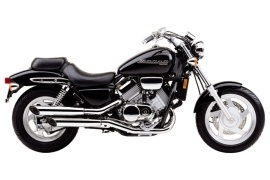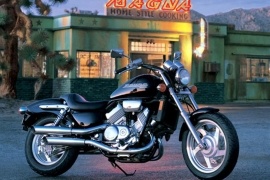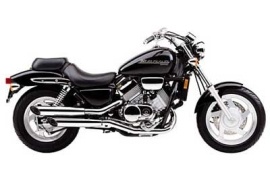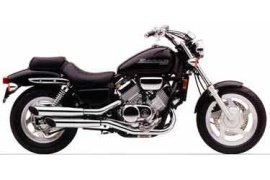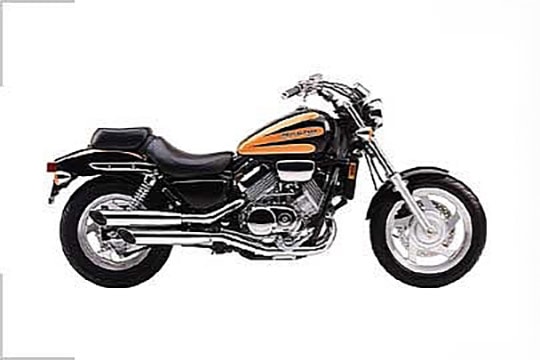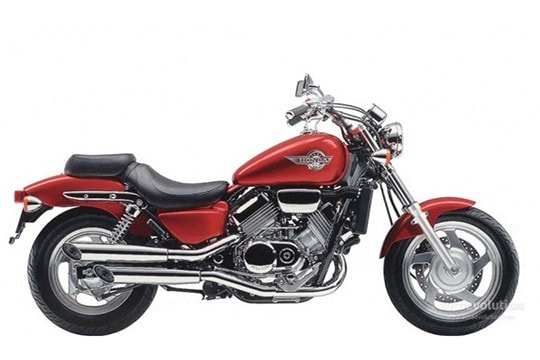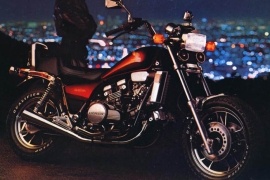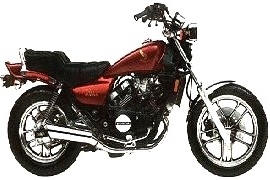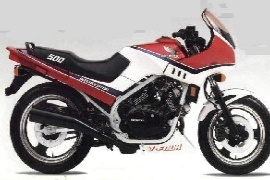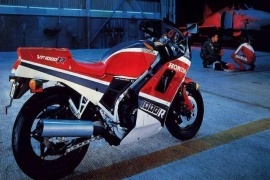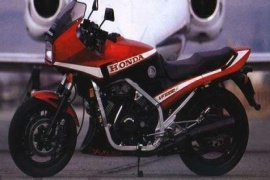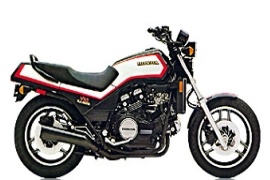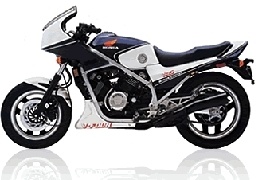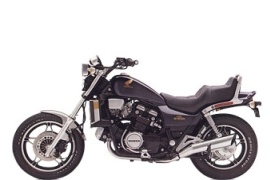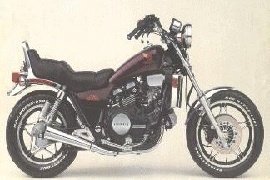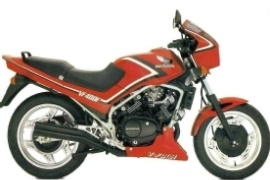HONDA VF Models/Series Timeline, Specifications & Photos
First production year: 1982
In 2002, the Japanese motorcycle manufacturer released the Honda VF750C Magna, a cruiser motorcycle with a cruiser chassis and a sports bike engine. The bike was in its ninth consecutive production year and packed the same characteristics as previous ones without modifications.
The Honda Magna was a cruiser motorcycle manufactured by Honda from 1982 to 1988 and 1994 to 2003. It was the second Honda motorcycle that used the new V4 engine, also shared with the VF750S Sabre. Later models packed a re-tuned engine from the VFR750F.
Visually, the motorcycle came with standard features, such as a round headlight upfront, a teardrop-shaped fuel tank, a two-piece dual seat with a removable passenger unit, a four-into-four exhaust system with two mufflers on each side, and five-spoke aluminum alloy wheels.
Regarding power, the 1999 Honda VF750C Magna was set in motion by a 748cc four-stroke V-four liquid-cooled engine mounted at its core, delivering an output power of 87 hp at 9,000 rpm and 70 Nm (51 lb-ft) torque at 7,250 rpm.
For suspension, the cruiser packed a 41 mm cartridge-type telescopic fork with 150 mm of travel on the front and five-way spring preload-adjustable side-mounted rear shocks with 99 mm of travel.
The braking power was achieved by a 316 mm brake disc mounted on the front wheel clamped to a twin-piston caliper and a drum braking unit on the rear.
The Honda Magna was a cruiser motorcycle produced by Honda from 1982 to 1988 and 1994 to 2003, as the second Honda motorcycle to pack the new V4 engine, which was also shared with the VF750S Sabre. Later models packed a re-tuned engine from the VFR750F.
In 2001, the Japanese maker released the Honda VF750C Magna, set in motion by a sports bike engine. The 2001 motorcycle packed the same characteristics as the previous one without any changes whatsoever.
The cruiser motorcycle was built around a steel frame with a 41 mm cartridge-type telescopic fork with 150 mm of travel on the front and five-way spring preload-adjustable side-mounted rear shocks with 99 mm of travel.
As for the stopping power, the motorcycle's wheels were fitted with a 316 mm brake disc mounted on the front wheel clamped to a twin-piston caliper and a drum braking unit on the rear, offering optimum braking power.
The bike's visual department was characterized by standard features, like a round headlight upfront, a teardrop-shaped fuel tank, a two-piece dual seat with a removable passenger unit, a four-into-four exhaust system with two mufflers on each side, and five-spoke aluminum alloy wheels.
Power-wise, the 2001 Honda VF750C Magna had installed a 748cc four-stroke V-four liquid-cooled engine underneath its stylish fuel tank, delivering 87 hp at 9,000 rpm and 70 Nm (51 lb-ft) torque at 7,250 rpm.
In 2000, the Japanese motorcycle maker released the Honda VF750C Magna, a cruiser motorcycle powered by a sports bike engine. It came in the same shape and form as the previous one without any modifications.
The Honda Magna was a cruiser motorcycle manufactured by Honda from 1982 to 1988 and 1994 to 2003. It was the second Honda motorcycle that used the new V4 engine, also shared with the VF750S Sabre. Later models packed a re-tuned engine from the VFR750F.
In the performance department, the 2000 Honda VF750C Magna had installed a 748cc four-stroke V-four liquid-cooled engine mounted at its core, fed by four carburetors, delivering an output power of 87 hp at 9,000 rpm and 70 Nm (51 lb-ft) torque at 7,250 rpm.
Visually, the bike had standard fittings, such as a round headlight upfront, a teardrop-shaped fuel tank, a two-piece dual seat with a removable passenger unit, a four-into-four exhaust system with two mufflers on each side, and five-spoke aluminum alloy wheels.
In the suspension department, the motorcycle packed a 41 mm cartridge-type telescopic fork with 150 mm of travel on the front and five-way spring preload-adjustable side-mounted rear shocks with 99 mm of travel.
As for the braking power, it packed a 316 mm brake disc mounted on the front wheel clamped to a twin-piston caliper and a drum braking unit on the rear, offering optimum stopping power.
In 1999, the Japanese motorcycle maker released the Honda VF750C Magna, a cruiser motorcycle launched in 1993 as an early release for the 1994 model year. In addition to the 1999 base model, the maker introduced a Deluxe version with different colors, more chrome, and a handlebar-mounted cowl.
The Honda Magna was a cruiser motorcycle manufactured by Honda from 1982 to 1988 and 1994 to 2003. It was the second Honda motorcycle that used the new V4 engine, also shared with the VF750S Sabre. Later models packed a re-tuned engine from the VFR750F.
Visually, the motorcycle came with standard features, such as a round headlight upfront, a teardrop-shaped fuel tank, a two-piece dual seat with a removable passenger unit, a four-into-four exhaust system with two mufflers on each side, and five-spoke aluminum alloy wheels.
For suspension, the cruiser packed a 41 mm cartridge-type telescopic fork with 150 mm of travel on the front and five-way spring preload-adjustable side-mounted rear shocks with 99 mm of travel.
The braking power was achieved by a 316 mm brake disc mounted on the front wheel clamped to a twin-piston caliper and a drum braking unit on the rear.
Regarding power, the 1999 Honda VF750C Magna was set in motion by a 748cc four-stroke V-four liquid-cooled engine mounted at its core, delivering an output power of 87 hp at 9,000 rpm and 70 Nm (51 lb-ft) torque at 7,250 rpm.
In 1995, the Japanese motorcycle maker released the Honda VF750C Magna Deluxe, a different kind of cruiser characterized by slash-cut exhausts on each side and a small handlebar-mounted cowl. The bike had a two-tone Pearl Purple and Pearl White color scheme and a black-finished model with Pearl Mint on the fuel tank.
The third generation Magna remained unchanged over its production time, packing features, such as a round headlight integrated into a small handlebar-mounted cowl with a small windscreen, a teardrop-shaped fuel tank, a two-piece dual seat, a four-into-four chromed exhaust system with two mufflers on each side, and five-spoke aluminum alloy wheels.
It was built around a steel frame with a 41 mm cartridge-type fork on the front, offering 150 mm of travel, and dual side-mounted five-way spring preload-adjustable shocks on the rear with 99 mm of travel.
In the braking department, the motorcycle's wheels were fitted with a 316 mm brake disc clamped to a dual-piston caliper and a single-leading shoe drum unit on the rear, offering optimum braking performance.
As for the power figures, the 1995 Honda VF750C Magna Deluxe had its soul brought to life by a 748cc four-stroke V-four liquid-cooled engine mounted at its core, delivering an output power of 87 hp at 9,000 rpm and 70 Nm (51 lb-ft) torque at 7,250 rpm.
The Honda Magna was a cruiser motorcycle produced by Honda from 1982 to 1988 and 1994 to 2003. It was the second Honda motorcycle that packed the new V4 engine, which was also shared with the VF750S Sabre. Later models packed a re-tuned engine from the VFR750F.
In 1994, the Japanese motorcycle maker introduced the Honda VF 750 C Magna, a third-generation cruiser motorcycle, launched in 1993 as an early release for the 1994 model year.
Honda's means was to capture the powerful cruiser market by borrowing the engine from the Honda VFR750 and mounting it in a cruiser chassis. As for the engine's look, it was complemented by extra chrome, some extra cooling fins, and the four-into-four chromed exhaust system.
In addition, the engine suffered several changes, including a different crankshaft, a five-speed manual transmission, chain-driven cams, and smaller carburetors, resulting in a stronger mid-range pull and a broad power band.
The bike's visual department was characterized by standard fittings like a round headlight, a wide, pulled-back handlebar, a teardrop-shaped fuel tank, a two-piece dual seat with a low rider seat, and a detachable passenger unit, a four-into-four chromed exhaust system with two silencers on each side, and five-spoke aluminum alloy wheels.
In terms of power, the 1994 Honda VF 750 C Magna had installed a 748cc liquid-cooled four-stroke V-four engine underneath its fuel tank, delivering an output power of 87 hp at 9,000 rpm and 69 Nm (51 lb-ft) torque at 7,250 rpm.
After various mechanical and cosmetic changes over the years, the basic core of the Mange motorcycle remained the same. Although it was not an official Honda name, the second generation 1987-1988 models were dubbed as the Super Magna by aficionados.
In 1987, the Japanese motorcycle maker introduced the Honda VF700C Super Magna, a cruiser motorcycle that replaced the 1986 VF700C Magna and was replaced by the 1994 VF750 Magna.
The bike was available in two color schemes, Candy Maroon and Candy Imperial Blue, complemented by chromed fenders and headlight housing. The 1987 model had a silver, grey, and black Honda "wing" tank decal, while the 1988 model had a silver "Magna" decal.
Visually, the motorcycle packed features like a round headlight, a teardrop-styled fuel tank, a one-piece, two-up seat, a four-into-four exhaust system with two up-swept mufflers on each side, an engine spoiler, and aluminum alloy wheels.
In the performance department, the 1987 Honda VF700C Super Magna had its soul brought to life by a 699cc liquid-cooled four-stroke four-cylinder engine that delivered an output power of 80 hp at 9,500 rpm and 62 Nm (46 lb-ft) torque at 7,500 rpm.
The suspension system comprised a 37 mm air-adjustable fork on the front and dual-sided shocks on the rear. As for the stopping power, the front wheel was coupled to two brake discs, while the rear wheel was controlled by a single disc.
In 1984, the Japanese motorcycle maker introduced the Honda VF 500C Magna V30, a standard motorcycle designed as a balanced bike that is more enjoyable and easier to ride in the city than its larger Magna siblings, offering great power and a broad torque band.
The bike's appearance was characterized by standard fittings, like a small square headlight upfront, a teardrop-shaped fuel tank, a one-piece dual seat with a small sissy bar, side-mounted rear shocks, a dual exhaust system with a muffler mounted on each side, and 10-spoke aluminum alloy wheels.
For suspension, the motorcycle packed an air-assisted telescopic fork on the front with 140 mm of travel and a dual-sided swingarm coupled to a single shock absorber with 115 mm wheel travel on the rear.
As for the braking performance, the motorcycle relied on two 255 mm brake discs mounted on the 16-inch front wheel and a drum braking unit mounted on the 18-inch rear wheel, offering optimum stopping power.
The 1984 Honda VF 500C Magna V30 was powered by a 499cc four-stroke four-cylinder liquid-cooled engine fed by four 34 mm Keihin carburetors, boasting 68 hp at 11,500 rpm and 43 Nm (32 lb-ft) torque at 10,500 rpm.
A six-speed manual transmission linked to the rear through a final chain drive pushed the motorcycle to a top speed of 196 kph (122 mph).
The Honda VF 500 F, also known as the Interceptor in the United States and Canadian markets, was a sports motorcycle made from 1984 until 1986 when it was replaced by the Honda CBR600F "Hurricane." It was known as one of the finest handling machines of the 1980s.
The bike was manufactured for the North American and European markets. The European version was also available in a fully faired version under the VF500F2 designation, while the basic version had an upper half fairing and an engine spoiler in front of the oil pan.
The motorcycle had a double-cradle steel frame with an air-assisted 37 mm telescopic fork on the front with 140 mm wheel travel and a Pro-Link four-way adjustable shock absorber on the rear with 115 mm wheel travel.
In the braking department, the motorcycle relied on two 255 mm brake discs with dual-piston calipers mounted on the front wheel and a 255 mm brake rotor with a single-piston caliper mounted on the rear wheel.
As for power, the 1984 Honda VF 500 F had installed a 498cc four-stroke liquid-cooled four-cylinder engine underneath its fuel tank. It was managed by four 32 mm Keihin carburetors and delivered 70 hp with maximum strength at 12,000 rpm and 42 Nm (31 lb-ft) torque at 10,500 rpm.
The bike’s power was controlled by a six-speed manual transmission that redirected the power to the rear end via a final chain drive, pushing the machine to a top speed of 206 kph (128 mph).
In 1984, the Japanese motorcycle maker introduced the Honda VF 1000 R, a fully faired motorcycle that came as a showcase of Honda technology developed on the racetrack with the FWS1000 race bike, designed to compete in the Daytona 200 and AMA F1.
The bike's aesthetic department was characterized by features such as a full fairing, a large square headlight, a medium-sized windscreen, a single seat with a removable passenger seat cover, a four-into-two exhaust system with a muffler on each side, and six-spoke alloy wheels.
In the performance department, the 1984 Honda VF 1000 R took its thrust from a 998cc four-stroke V-four liquid-cooled engine fed by four 34 mm carburetors, delivering 130 hp at10,500 rpm and 92 Nm (68 lb-ft) torque at 8,000 rpm.
All the energy generated by the engine was controlled by a five-speed manual transmission and sent to the rear axle through a final chain drive, launching the motorcycle to a top speed of 240 kph (149 mph).
As for handling, the bike's frame was fitted with a 41 mm air-assisted three-way adjustable fork on the front with 155 mm wheel travel and a three-way adjustable air-assisted shock absorber on the rear, offering excellent suspension performance.
In the braking department, the bike relied on two 285 mm brake rotors with four-piston calipers mounted on the front wheel and a 285 mm brake disc with a single-piston caliper mounted on the rear wheel.
The VF 1000F has a liquid cooled, four stroke, 90 degrees, V four cylinders, 998cc engine which could develop 116 horsepower at 10000rpm and a torque of 86 Nm at 8000rpm.
In 1984, the Japanese motorcycle maker introduced the Honda VF1100S Sabre, also known as the V65, which denoted its displacement in cubic inch. It was a high-performance motorcycle known for its record-shattering quarter-mile performance and V-four engine.
In the visual department, the motorcycle was packed with six-spoke aluminum wheels, a center stand, a four-into-two exhaust system with a muffler on each side, a one-piece, two-up seat with a passenger grab handle, and a rectangular headlight mounted on the fork.
For suspension, the motorcycle packed a 41 mm air-assisted three-way adjustable telescopic fork on the front with 145 mm of travel and a three-way adjustable Pro-Link shock absorber on the rear, offering excellent suspension performance and handling.
The bike's wheels were fitted with two 274 mm brake discs clamped to dual-piston calipers on the front and a 279 mm brake rotor on the rear with a two-piston caliper, providing excellent stopping performance.
The 1984 Honda V65/VF1100S Sabre had its heartbeat set by a 1,098cc four-stroke four-cylinder liquid-cooled engine that delivered an output power of 121 hp with a peak force at 9,500 rpm and 94 Nm (69 lb-ft) torque at 7,500 rpm.
A six-speed manual transmission with a wet clutch took the power generated by the engine and sent it to the rear end through a final shaft drive, launching the motorcycle to a maximum speed of 284 kph (177 mph).
In 1983, the Japanese motorcycle maker introduced the Honda VF 750 Interceptor, Honda's first sports bike with a racing DNA running through its internals. The bike was developed with new Honda Grand Prix technology like a track-inspired fairing, a 16-inch front wheel, a rectangular-section perimeter frame, and an anti-dive front suspension.
The visual department was characterized by features such as a large front cowl with a square headlight, a small windscreen, a one-piece dual seat with passenger grab rails, a four-into-two exhaust system with a muffler on each side, an engine spoiler, and six-spoke aluminum alloy wheels.
It was built around a box-section steel frame with a 39 mm four-way adjustable Showa fork on the front, offering 154 mm of travel, and a four-way-adjustable Showa shock absorber on the rear with 112 mm of travel.
In the braking department, the bike's 16-inch front wheel was controlled by two 270 mm discs clamped to hydraulic calipers and a 288 mm brake disc on the rear with a hydraulic caliper.
As for the power figures, the 1983 Honda VF 750 Interceptor had installed a 748cc four-stroke four-cylinder liquid-cooled engine under the fuel tank, boasting 86 hp at 10,000 rpm and 63 Nm (46 lb-ft) torque at 7,500 rpm.
The rear wheel was spun by a final chain drive linked to a five-speed manual transmission that handled the engine's energy, pushing the motorcycle to a top speed of 216 kph (134 mph).
The Honda Magna was a cruiser motorcycle produced by Honda from 1982 to 1988 and 1994 to 2003. It was the second motorcycle created by Honda to feature the new V4 engine, also available on the Honda VF750S Sabre.
In 1983, the Japanese motorcycle manufacturer introduced the Honda VF 1100 C, also known as the V65. The model appeared in the Guinness Book of World Records from 1986 to 1989 as the fastest production cruiser motorcycle with a top speed of 278-283 kph (173-176 mph).
The bike's appearance was characterized by features such as a single headlight unit upfront, a teardrop-shaped fuel tank, a one-piece dual seat with a pillion grab rail, side-mounted rear shocks, a dual exhaust system with a muffler mounted on each side, and five-spoke aluminum alloy wheels.
The suspension system comprised a 41 mm air-assisted telescopic fork mounted on the front with 150 mm of travel and two spring, rebound, and compression-adjustable shock absorbers on the rear with 105 mm of travel.
As for the stopping power, the motorcycle packed two 270 mm brake rotors clamped to dual-piston calipers controlling the front and a 282 mm brake disc with a twin-piston caliper handling the rear wheel.
The 1983 Honda VF 1100 C had its soul brought to life by a 1,098cc four-stroke liquid-cooled V-four engine, boasting 116 hp at 7,500 rpm and 94 Nm (69 lb-ft) torque at 7,500 rpm.
The Honda Magna was a cruiser motorcycle manufactured by Honda from 1982 to 1988 and 1994 to 2003. It was the second Honda motorcycle that used the new V4 engine, also shared with the VF750S Sabre. Later models packed a re-tuned engine from the VFR750F.
In 1982, the Japanese motorcycle maker introduced the Honda VF 750 C Magna, a cruiser motorcycle also known as the VF750C and V45. It was part of the first generation, including a chromed headlight and chromed fenders.
The bike's visual department was characterized by standard features, such as a chromed front fender, a round headlight with a chromed housing, a wide, pulled-back handlebar, a one-piece, two-up seat with a small sissy bar, a chromed rear fender, side-mounted rear shocks, a dual chromed exhaust system with a silencer on each side, and five-spoke aluminum alloy wheels.
For suspension, the motorcycle packed a 39 mm air-assisted, four-way anti-dive adjustable telescopic fork on the front and dual shock spring preload-adjustable shocks on the rear, providing optimum handling capabilities.
As for the braking power, the bike's 18-inch front wheel was fitted with two 275 mm brake discs, while the 16-inch rear wheel was controlled by a drum braking unit.
Regarding power, the 1982 Honda VF 750 C Magna had its heartbeat set by a 748cc liquid-cooled four-stroke V-four engine managed by four 32 mm Keihin carburetors, boasting 79 hp at 9,500 rpm and 66 Nm (49 lb-ft) torque at 7,500 rpm.
The Honda VF 400 F was a naked, standard motorcycle manufactured by Honda for only two years, in 1982 and 1983. It was powered by a 400cc four-stroke V4 engine, had Honda's Torque Reactive Anti Dive Control (TRAC) system, and air-assisted suspension both front and rear.
In 1982, the Japanese motorcycle manufacturer introduced the Honda VF 400 F, a standard, naked motorcycle with a bikini cowl resembling the MVX250F model. The bike's engine was the perfect replica of Honda's VF750 model and had everything its big brother had.
The bike's aesthetic department was characterized by features such as a square headlight integrated into a bikini cowl, a small windscreen, a one-piece two-up seat with a passenger grab rail, a dual exhaust system with a silencer on each side, an engine spoiler, and aluminum alloy wheels.
The bike was built around a double-cradle steel frame with a telescopic, cylindrical air cushion fork on the front and a dual-sided swingarm with a single shock absorber on the rear, offering optimum handling capabilities.
As for power, the 1982 Honda VF 400 F had its heartbeat set by a 399cc four-stroke V-four liquid-cooled engine mounted at its core, boasting 55 hp with a peak at 12,500 rpm and 35 Nm (26 lb-ft) torque at 10,500 rpm.
